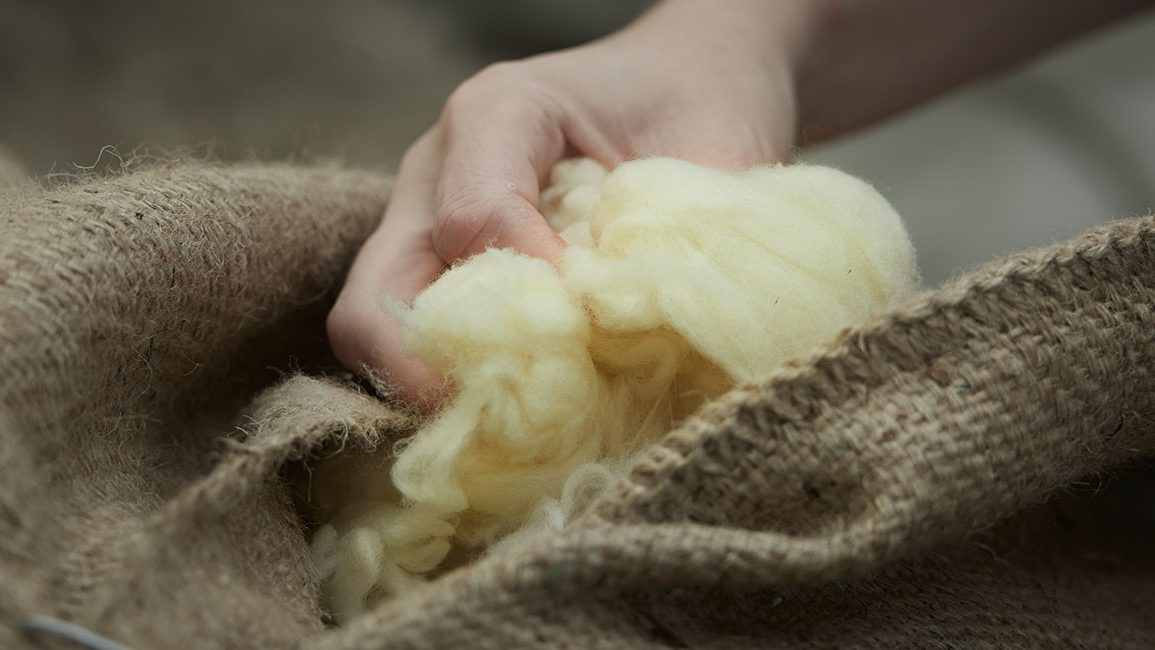Wool has many unique characteristics which make it ideal for weaving into beautiful wool blankets with exceptional comfort and warmth. Types of wool are varied, with different breeds of sheep and other woolly animals producing distinct varieties of wool, each with their own qualities. Our guide to understanding the different types of wool can help you to navigate the many options when choosing wool bedding.
Lambswool, merino, pure new wool, cashmere. They all vary in handle, weight, softness and of course, price; however, these different types of wool all share common attributes. Wool is a sustainable and fully renewable fibre with the animal producing a new fleece each year. It naturally biodegrades on land and in water, and as it’s protein-based, does not contribute to microplastic pollution. Wool also reduces waste to landfill as it decomposes naturally in soil, whilst slowly releasing valuable nutrients back into the earth.
Wool may just be the key to getting a better night’s sleep, and not just for its sustainable benefits. It reacts to changes in body temperature, regulating heat and keeping you in the thermal comfort zone through the night. This, in turn, minimises disruptions and improves the quality of your sleep – studies show by up to 25%! Wool bedding, unlike synthetic duvets and linen, absorbs moisture and draws it away from your body, meaning you’re much less likely to wake up sweaty and uncomfortable.
Wool is hypoallergenic – it is resistant to bacteria, mould and mildew that can trigger allergic reactions in many people. Its microscopic pores respond to changes in humidity making it unfavourable for the growth and breeding of dust mites. It is also highly effective at repelling fugal spores, a common cause of night-time allergies such as sneezing and itchy eyes.
Pure New Wool
Pure new wool comes from the fleece produced naturally by sheep each year. The term describes wool that has not been previously used, blended with any other fibres, or sustained any wear. Products made from pure new wool are practical and insulating, with a lofty surface that is slightly courser than merino or lambswool. Browse our range of warming pure new wool blankets and throws.
The slightly scratchier handle of a pure new wool blanket means that it is not for everyone. If you are looking for a finer, softer texture to sit against the skin, consider a finer fibre, such as merino wool or lambswool.
Merino Wool
Merino is an ultrafine wool that comes specifically from the merino sheep, a prized breed commonly found in Australia and New Zealand. The fine fibres of merino wool are extremely soft and lay comfortably next to the skin, meaning merino wool blankets and bedding made from this luxury fibre can be used as an alternative to a synthetic duvet, bringing with it all the benefits of wool we’ve already mentioned.
Merino is the ultimate temperature regulator when it comes to comparing the different types of wool, as merino sheep survive comfortably in extreme temperatures, both low and high. When it’s cold, merino’s natural crimp traps air, insulating the body, and when it’s warm, it wicks moisture away from the skin and releases it as vapour, helping to keep you cool and dry. In the cold winter months, two or more merino wool blankets can be layered to lock in extra warmth. Each layer releases sweat and moisture, helping to keep you warm and dry without getting clammy. This also makes is why merino wool is also the ideal material for a baby blanket, be sure to take a look at our merino baby blanket for more information.
Lambswool
Lambswool is taken from the first shearing of the sheep, usually at around seven months old. It is extremely fine and soft, and when it’s spun, produces a beautiful high-quality yarn that is perfect for weaving into super soft blankets. As it is the first shearing of the sheep, it is produced in smaller quantities, making it more exclusive and therefore more expensive than merino and other wools.
Browse our range of lambswool blankets.
Cashmere
Cashmere is one of the most highly regarded luxury fibres in the world due to its silky-smooth handle and silk-like drape. The yarn comes from rare fibres taken from the underbelly of cashmere goats living in harsh climates, mainly in Mongolia and China. These animals have adapted to significant temperature fluctuations by developing a double fleece; keeping them warm and insulated in winter and cool in summer.
Cashmere fibres produce the finest, softest, and warmest blankets, but also cashmere blankets with superior durability which can last for many years and from generation to generation.


